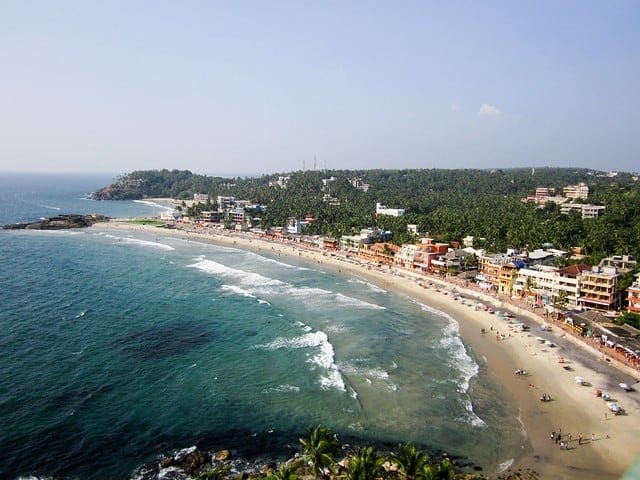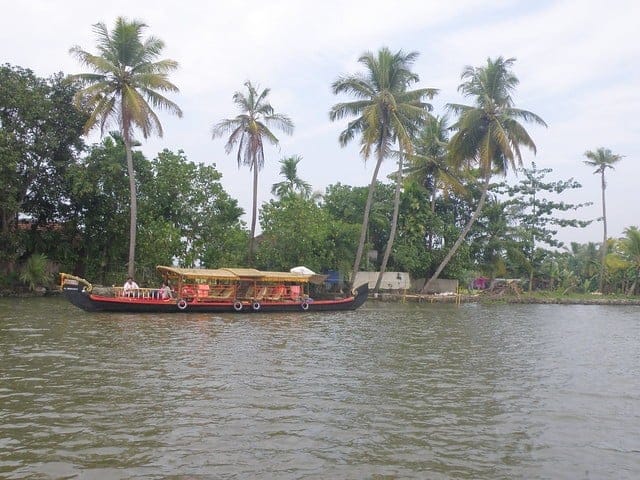Kerala, God’s own country is one of the most famous tourist places in India. For explorers from across the world, it is a promising coastal state that lies between the Western Ghats and the Arabian Sea, offering diverse and dynamic experiences. The land is capable of pleasing tourists throughout the seasons. Golden beaches, unique emerald backwaters, high mountain ranges, beautiful hill stations, culturally rich art forms, delightful cuisines; the options are many to relish at Kerala. There are many tourist destinations in the state that are equally ideal for families, honeymoon couples, adventurists, and solo backpackers. Listed below are the some of the best tourist spots in Kerala which makes the place a must-to-visit destination.
- Alleppey, The Venice of east welcomes you!
Alleppey (Alappuzha) is an inevitable choice to be included in your bucket list if you visit Kerala. Known by the title, The Venice of East, Alleppey is a perfect destination of backwaters and beaches which is an ideal place to spend your houseboat vacation. The exploring of watery routes in the age-old transportation facility houseboat can even provide you luxuries equivalent to a 5-star hotel.
The sight of scenic landscape and backwatering through coconut groves, paddy fields, villages, water lilies, and ducks will give you a soothing effect. The excited cuisines offered there is the fresh produce from the water into your plate. The bliss you earn from there will be remembered all the time.
The main attractions of Alleppey are the Alleppey beach, Marari Baech, Punnamadas lake, Krishnapuram Palace, Ravi Karunakaran Museum, Pathirmanal island, and Sri Krishna temple Ambalappuzha. The snake boat race held at Alleppey during August o September is another attraction.
The best time to visit Alleppey: September to May
Nearest airport: Kochi International Airport is 53 km away from the place
Nearest railway station: Alleppey Railway Station.
- Munnar, The Kashmir of Kerala
Munnar is one of the widely attracted tourist places in Kerala for its natural beauty. Located at an altitude of 6000 ft. above the sea level, Munnar is a town of excess charm. The mind soothing climate of the hills and mountains covered with tea plantations. About 80,000 miles of hills are covered with tea plantations. The cold climate and the mind-blowing sights make Munnar undoubtedly a place for Honeymoon. The ancient colonial ambiance of Munnar is evident through the TATA tea Museum. The comfortable stays, trekkings, camps make your days in Munnar the most memorable in your life.
The major attractions of Munnar include Anamudi, Top station, Eravikulam national park, Attukal waterfalls, TATA tea museum, Meesapulimala, Marayoor Dolmens, Mattupetty dam, Kundala lake, Blossom Park, Pothenmedu vide point, Indo-Swiss dairy farm, Life of Pi Church and Lockhart Gap.
The best time to visit Munnar: October to March
Nearest airport: Kochi International Airport which is located 143 km away
Nearest railway station: Aluva Railway Station which is located 110 km away.
- Kovalam, Experience the beauty of Beach

Kovalam is one of the must-visit tourist places in Kerala for its beach beauty. Kovalam offers cherished experiences for lots of tourists. The pleasant weather, soft sand, eye catchy blue sea, a soothing sea breeze, and the tall coconut trees aside the beach makes the place a miniature of paradise.
The tourists there are allowed to involve in swimming, surfing, bask under the sun, and enjoy the lip-smacking seafood. The mind soothing body massage is another attraction where both the mind and body are nurtured. There are various accommodation facilities for every kind of visitors ranging from the cheapest to most luxurious ones. You can relax in the sunbathing and get engaged snorkeling, parasailing etc.
The main attractions of Kovalam include Hawah beach, Samudra beach, Vizhinjam marine aquarium, Fishing harbor, Akkulam Lake, Aruvikkara, Rock cut cave, Karamana River, Thiruvallam parasurama temple, Kovalam Juma masjid and Valiathura Pier.
The best time to visit: September to May
Nearest airport: Trivandrum International Airport which is 15km away.
Nearest Railway Station: Trivandrum Railway Station is 14 km away.
- Fort Kochi, ¬¬¬¬The gateway of Kerala
Fort Kochi, considered as the gateway of Kerala is one of the most attractive tourist spots in Kerala. Fort Kochi is the main attraction of the Queen of the Arabian Sea with a multitude of personalities. The ancient city possesses a wide heritage and multi-ethnic culture. Being a most visited place in Kerala, Fort Kochi is an ideal destination for nature lovers, tourists and history buffs. The mind-blowing sights, delicious seafood, museums, palaces, synagogues, heritage buildings, beaches, art galleries, churches, Hindu temples etc makes Fort Kochi a promising land for exploring. People will not leave Fort Kochi without savoring the multi cuisines and grab some reminiscence to home.
The major attractions of Fort Kochi are the Bolgatty Palace, Mattancherry Palace, Paradesi Synagogue, Santa Cruz Basilica, Hill palace, Willingdon Island, Museum of Kerala history, St. Francis Church, Marine Drive, Ernakulam Shiva temple, the sunsets and sunrise near the Chinese fishing net and Kodanad Elephant training center etc.
The best time to visit Fort Kochi: September to March
Nearest Airport: Kochi International Airport
Nearest Railway Station: Ernakulam Junction which is located 13 km away
- Thekkady, Experience the wilderness
Thekkady is one of the top-ranked tourist destinations in Kerala. It is blessed with the wild beauty cuddled with the lush greenery of the Western Ghats and the dense forest. The Periyar wildlife sanctuary nearby the Periyar Lake is known for the tourist delight. It is one of the 27 Tiger reserves in India which is a home for 35 diverse species of fauna such as Tigers, wild Elephants, Sambars, and Gaurs etc. other than this, there are coffee and many spices plantations in Thekkady which is another attraction of the place. There are around 265 species of birds. You can enjoy the wild beauty of Thekkady through adventurous jungle safaris, patrols, bamboo rafting, border hiking, and camps.
The main attractions of Thekkady include Rmakkalmedu, Kumily, Elephant Junction, Periyar wildlife sanctuary, Periyar Lake, Deepa world spice and Ayurvedic Garden, Mudra cultural center, Mullaperiyar Dam, Chellarkovil, Vandanmedu, Murikkady, Periyar Tiger Trail and Kadathanadan Kalari Center.
The best time to visit Thekkady: November to May
Nearest Airport: Karipur International Airport which is situated 95 km away
Nearest Railway Station: Kottayam Railway Station which is situated 114 km away.
- Wayanad, The symbol of scenic beauty
Wayanad is the proof of why Kerala is called God’s own country. It is the greenest place to visit in Kerala. The ravishing wild beauty with the adventurous trekking experiences makes the place a must-to-visit spot in Kerala. The comfortable stays in the soothing climate and wild ambiance of Wayanad are promising.
Real-time experience of the tribal heritages from more than 50 tribe dwellings in Wayanad is uniqueness about Wayanad expedition. Trekking and camping is another factor which attracts tourists from various parts of the worlds. You can even try your fortune if you spot the Neelakurinji flower which blooms once in 12 years.
Major attractions of Wayanad are Banasura Sagar Dam, Edakkal caves, Wayanad Wildlife Sanctuary, Papanashini river, Kuruva dweep, Thusharagiri waterfalls, Thirunelli temple, Lakkidi viewpoint, Puliyarmala Jian, and Padinjarathara Dam.
Best time to visit Wayanad: October to May. Also, you can enjoy the trip to Wayanad during Monsoon seasons.
Nearest Airport: Karipur International Airport which is located 95 km away
Nearest Railway Station: Kozhikode Railway Station which is located 72 km away.
- Kumarakom, Enjoy the contours of Vembanad Lake
Kumarakom is a famous tourist destination in Kerala known for backwatering and bird sanctuary. The peaceful hamlet possesses enthralling sceneries, exotic environment, and cool weather. Being one of the best places to visit in Kerala, Kumarakom gives you a mind-blowing experience in backwatering through the fresh paddy fields, coconut groves, and villages. The relaxing houseboat rides are available for all type of tourists at cheap rates too expensive ones. The delightful cuisines of Kumarakom should be tried at least once.
The Kumarakom Bird Sanctuary is a must-to-go place in Kerala which homes to a wide variety of bird species that mainly includes migratory birds and Siberian storks.
The major attractions of Kumarakom are The Kumarakom Bird Sanctuary, Kumarakom Backwaters, Aruvikkuzhi waterfalls, Vembanad Lake, Pathiramanal Island, Kumarakom beach, Bay Island Driftwood Museum, Thriunakkara Mahadeva temple, Cheiryapally, Valiyapally etc.
The ideal time to visit Kumarakom: September to May
Nearest Airport: Kochi International Airport which is located 85 km away.
Nearest Railway station: Kottayam Railway station which is situated 16 km away.
